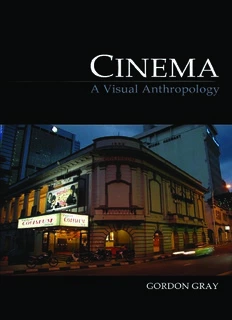
Preview Cinema: A Visual Anthropology
CINEMA Key Texts in the Anthropology of Visual and Material Culture Editor: Marcus Banks Key Texts in the Anthropology of Visual and Material Culture is an innovative series of access ible texts designed for students. Each volume concisely introduces and analyses core topics in the study of visual anthropology and material culture from a distinctively anthropological perspective. Titles in this series include: Cinema: A Visual Anthropology Forthcoming titles: Museums: A Visual Anthropology CINEMA A Visual Anthropology Gordon Gray Oxford • New York English edition First published in 2010 by Berg Editorial offices: First Floor, Angel Court, 81 St Clements Street, Oxford OX4 1AW, UK 175 Fifth Avenue, New York, NY 10010, USA © Gordon Gray 2010 All rights reserved. No part of this publication may be reproduced in any form or by any means without the written permission of Berg. Berg is the imprint of Oxford International Publishers Ltd. Library of Congress Cataloging-in-Publication Data Gray, Gordon Cinema : a visual anthropology / Gordon Gray. — English ed. p. cm. — (Key texts in the anthropology of visual and material culture) Includes bibliographical references and index. ISBN 9781845207939 (cloth) — ISBN 9781845207946 (pbk.) 1. Motion pictures in ethnology. 2. Visual anthropology. I. Title. GN347.G723 2010 301—dc22 2009045269 British Library Cataloguing-in-Publication Data A catalogue record for this book is available from the British Library. ISBN 978 1 84520 793 9 (Cloth) 978 1 84520 794 6 (Paper) Typeset by JS Typesetting Ltd, Porthcawl, Mid Glamorgan Printed in the UK by the MPG Books Group www.bergpublishers.com CoNtENts List of Illustrations vii Introduction ix Suggested Further Reading xvii 1 The History of Cinema 1 Introduction 2 Precursors 3 Early Cinema 5 The “Golden Era” of Fiction Film 15 Auteurs, Independents, and Global Blockbusters 28 Suggested Further Reading 33 2 Film Theory 35 Introduction 36 Early Film Theory 37 Critical Film Theories 45 Suggested Further Reading 73 3 Context of Production, Distribution, and Exhibition 75 Introduction 76 Context of Production 77 Third Cinema 88 Contexts of Distribution and Exhibition 96 Social and Cultural Contexts – Anthropology of the Cinema 99 Suggested Further Reading 107 vi contents 4 Context of Reception 109 Introduction 110 Reception and Audience Studies 112 Suggested Further Reading 133 Conclusion 135 Notes 143 Bibliography 147 Index 157 LIst of ILLustrAtIoNs I.1 Local cinema in the Asakusa district of Tokyo, Japan. ix 1.1 Toshiro Mifune and Machiko Kyo in a scene from Rashomon. 1 1.2 Scene from Le Voyage dans la Lune [Voyage to the Moon] (G. Méliès 1902). 7 1.3 George Siegmann and Lillian Gish in a scene from The Birth of a Nation (D. W. Griffith 1915). 8 1.4 Max Schreck in a scene from Nosferatu (F. W. Murnau 1922). 12 1.5 Actress Aishwarya Rai in a Bollywood song and dance number from Bride and Prejudice (G. Chadha 2004). 18 1.6 Filming Casablanca. Humphrey Bogart and Ingrid Bergman (M. Curtiz 1942). 19 1.7 An example of the Golden Age “Picture Palace” – the Eros Cinema Mumbai, India. Built in 1938. 20 1.8 Robert De Niro in Taxi Driver (M. Scorsese 1976). 27 1.9 Movie poster for Terminator 2: Judgment Day (J. Cameron 1991). 31 2.1 An arthouse cinema in Nagoya, Japan. 35 2.2 Orson Welles in a seminal scene from the expressionist influenced The Third Man (C. Reed 1949). 40 2.3 Director Orson Welles and cinematographer Gregg Toland filming Citizen Kane (O. Welles 1941). 48 2.4 Palace Talkies theatre Mumbai India. Built for millworkers. 51 2.5 Some Bollywood codes on display – handdrawn movie posters on a wall in Bangalore, India. 57 2.6 Stall selling Nigerian VCDs at the multicultural Kwakoe festival in the Bijlmermeer district of Amsterdam, the Netherlands. 65 2.7 Projectionist checking the equipment at the Elgin Talkies movie theatre (built in 1896) Bangalore, India. The equipment is from the 1930s. 71 3.1 Cinema in Marrakesh, Morocco. 75 viii list of illustrations 3.2 Partially hand drawn poster advertising JeanClaude Van Damme in JCVD (El Mechri 2008) – Nagoya. Japan. 78 3.3 Inside the Elgin Talkies cinema hall (built in 1896) Shivaji Road in Shivaji Nagar district of Bangalore, India. 80 3.4 Cinema in Gunung Sitoli, Nias Island, Indonesia. 82 3.5 Facade of the colonialera Elgin Talkies cinema hall building (built in 1896) in Bangalore, India. 87 3.6 Sign outside the abandoned Cine Oriente in the center of Santiago de Cuba, Cuba. 91 3.7 While cineplexes exist throughout Africa, films are also viewed in unexpected places, such as this cinema in Gambia. 106 4.1 Cathay Cinema in Shanghai, China. 109 4.2 Cinemagoers at the entrance of the Elgin Talkies cinema in Bangalore, India. 111 4.3 Films are not only watched in cinemas, the Special Video Club, Gambia. 122 4.4 Nollywood VCDs on display at a stall at the multicultural Kwakoe festival in the Bijlmermeer district of Amsterdam, the Netherlands. 127 4.5 Closeup of Nollywood VCDs on display at a stall at the multicultural Kwakoe festival in the Bijlmermeer district of Amsterdam, the Netherlands. 128 C.1 Cineplex in Japan. 135 INtroduCtIoN Figure I.1 Local cinema in the Asakusa district of Tokyo, Japan. Photograph by Erik Katerborg, 2008. So in viewing Rashomon we cognitively “know” and affectively “feel” in relation to a series of events that never took place, that are not real, that are “only a film.” Furthermore, as the very first philosopher to write about film, Hugo Munsterberg, argued, we experience and feel the film world all the while knowing it is not real; knowing that its apartness from our world is absurd, yet enjoying it. We are not fooled. How can this be, and what is the nature of the suspension of credibility that allows cognition and affect to work, but not so as to deceive us into mistaking the film’s world for real? Jarvie, Philosophy of the Film: Epistemology, Ontology, Aesthetics
Description: